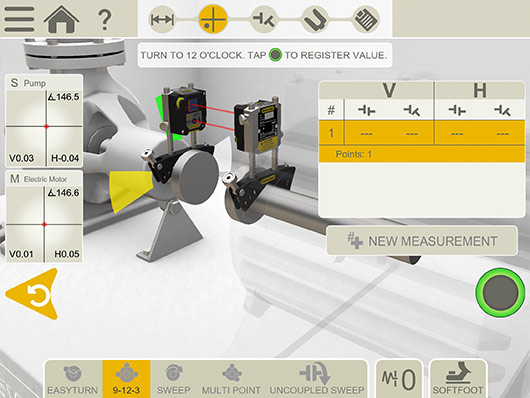
Laser Shaft Alignment with Five Different Measurement Methods
Laser Shaft Alignment with Five Different Measurement Methods
The five shaft alignment measurement methods are 9-12-3, EasyTurn™, Multipoint, Continuous sweep and the latest edition, Uncoupled Sweep. Here we describe them individually, so that you know when best to use them.
The rotation of the measurement devices around the shaft is similar to that of a clock; positions 9, 12, 3 and 6.
Shaft Alignment Method 1: 9-12-3

The clock method, or 9-12-3 as it is also known, is the origin of all shaft alignment. Anyone who knows how to use analogue dial indicators will recognize this method. A dial gauge is mounted on each shaft, and the measurement values taken at three different points, corresponding to the 9-12-3 positions on a clock, or the angles 0-90-180 of a circle. It is based on geometry (and trigonometry), more specifically circle mathematics. The mathematical assumption is that if we can measure the semicircle, we can then work out what the whole circle will look like, and consequently determine the centre of the circle (rotational centre) for both shafts. These centres can then be compared to each other and we can thus work out how well-aligned the machines are to each other. And with a laser-based measurement system, also obtain direct feedback from the adjustment of the machine in real time.
Shaft Alignment Method 2: EASYTURN

EasyTurn is a unique further development of the shaft alignment 9-12-3 method, with the freedom to choose at which clock position (which angle) you start collecting measurement values. With the help of some mathematics, we can also restrict the total measurement range to 40 degrees full rotation. From a practical point of view, this means that you can use this method where there is limited possibility of rotating the machines, due to the lack of space around the shafts.
This method is the standard setting for the Easy-Laser XT440 Shaft Alignment tool. Measurement method EasyTurn offers down to 20° between measuring points. Great when machine protection or pipes prevent precise positioning according to the clock method.
Shaft Alignment Method 3: MULTIPOINT

Multipoint is, in turn, a further development of shaft measurement method EasyTurn. Multipoint also means that you can start collecting measurement values from any clock position (angle), and complete collection across as small a rotation as 40 degrees. However, as the name suggests, this method means that values are collected from more than three points.
This is advantageous if taking shaft measurements from larger machines where it is difficult to rotate the shafts. Collect the measurement values across a shorter rotation to increase the mathematical probability of obtaining good measurement values. This method also gives a quality evaluation of the measurement series. The evaluation takes into account shifts in temperature, measurement direction and number of measuring points.
Shaft Alignment Method 4: CONTINUOUS SWEEP

Continuous sweep can be described as Multipoint with automatic, continuous measurement value collection. In practice, this means that you can collect measurement values continuously with the measurement devices in motion i.e., you start measurement value collection (at any clock position/angle) and then rotate the shafts without stopping, in one direction. Continue until you have collected enough measurement values to achieve a good quality calculation (quality evaluation is also performed here just as in Multipoint).
Continuous sweep is best used when it is difficult to stop the machines to register measurement values.
At the end, the shafts’ rotational centre is calculated and presented graphically via images and text. This method is very useful in instances where it is difficult to stop the machines to take stationary measuring points, for example, when aligning large turbines.
Shaft Alignment Method 5: UNCOUPLED SWEEP

Here is a method that, as the name suggests, allows you to measure machines where you are required to align uncoupled. You rotate one shaft/unit at a time and let the beam pass over the other (stationary) unit. As one unit passes the other, the value is automatically recorded and the stationary unit is then moved to the next position. You can start anywhere on the turn and register an unlimited number of readings.
The Uncoupled sweep method is especially useful when only one (or none) of the shafts can be rotated manually.
We hope you now have a clearer picture of the various measurement methods and when best to use them. If you download our free XT Alignment app you can try them all out in demo mode! The app is available in Google Play or the App Store .
(All methods described in this article can be used with all XT shaft alignment systems, except for XT440 which features 9-12-3 and EasyTurn only.)
This post was written by our partner Easy-Laser® AB and can also be viewed on their Blog here. Enjoy!



0 comments
Write a comment